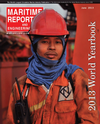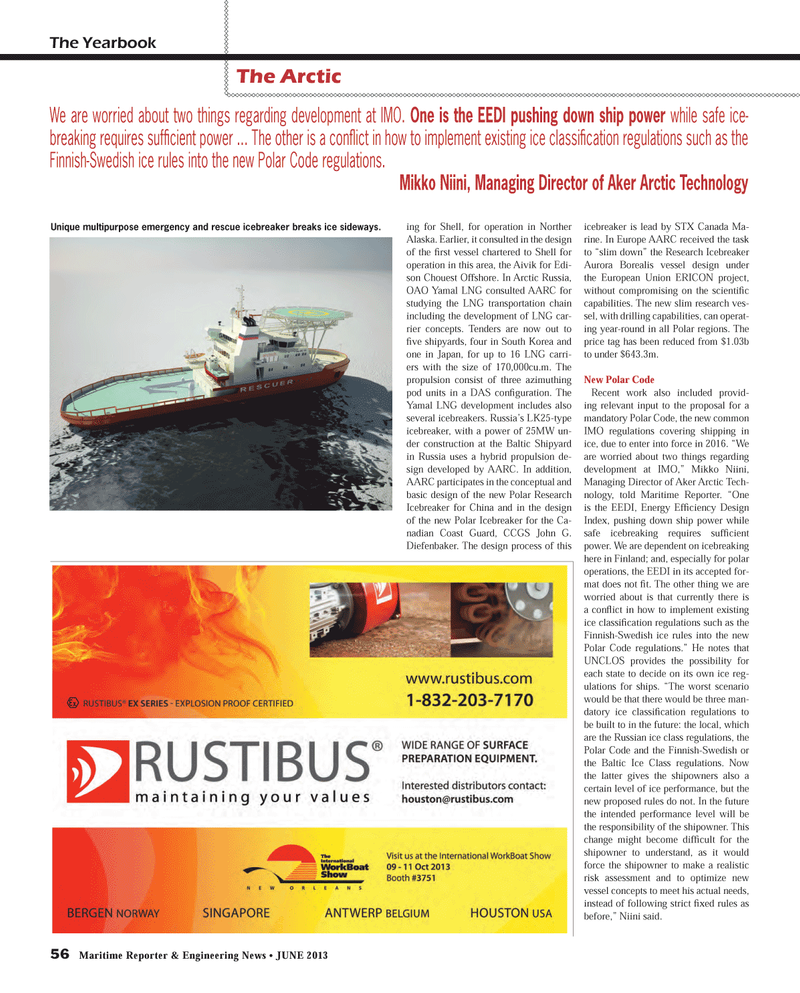
Page 56: of Maritime Reporter Magazine (June 2013)
Annual World Yearbook
Read this page in Pdf, Flash or Html5 edition of June 2013 Maritime Reporter Magazine
56 Maritime Reporter & Engineering News ? JUNE 2013 ing for Shell, for operation in Norther Alaska. Earlier, it consulted in the design of the Þ rst vessel chartered to Shell for operation in this area, the Aivik for Edi- son Chouest Offshore. In Arctic Russia, OAO Yamal LNG consulted AARC for studying the LNG transportation chain including the development of LNG car- rier concepts. Tenders are now out to Þ ve shipyards, four in South Korea and one in Japan, for up to 16 LNG carri-ers with the size of 170,000cu.m. The propulsion consist of three azimuthing pod units in a DAS conÞ guration. The Yamal LNG development includes also several icebreakers. Russia?s LK25-type icebreaker, with a power of 25MW un- der construction at the Baltic Shipyard in Russia uses a hybrid propulsion de-sign developed by AARC. In addition, AARC participates in the conceptual and basic design of the new Polar Research Icebreaker for China and in the design of the new Polar Icebreaker for the Ca-nadian Coast Guard, CCGS John G. Diefenbaker. The design process of this icebreaker is lead by STX Canada Ma-rine. In Europe AARC received the task to ?slim down? the Research Icebreaker Aurora Borealis vessel design under the European Union ERICON project, without compromising on the scientiÞ c capabilities. The new slim research ves- sel, with drilling capabilities, can operat-ing year-round in all Polar regions. The price tag has been reduced from $1.03b to under $643.3m. New Polar Code Recent work also included provid-ing relevant input to the proposal for a mandatory Polar Code, the new common IMO regulations covering shipping in ice, due to enter into force in 2016. ?We are worried about two things regarding development at IMO,? Mikko Niini, Managing Director of Aker Arctic Tech- nology, told Maritime Reporter. ?One is the EEDI, Energy Ef Þ ciency Design Index, pushing down ship power while safe icebreaking requires sufÞ cient power. We are dependent on icebreaking here in Finland; and, especially for polar operations, the EEDI in its accepted for- mat does not Þ t. The other thing we are worried about is that currently there is a conß ict in how to implement existing ice classiÞ cation regulations such as the Finnish-Swedish ice rules into the new Polar Code regulations.? He notes that UNCLOS provides the possibility for each state to decide on its own ice reg-ulations for ships. ?The worst scenario would be that there would be three man-datory ice classiÞ cation regulations to be built to in the future: the local, which are the Russian ice class regulations, the Polar Code and the Finnish-Swedish or the Baltic Ice Class regulations. Now the latter gives the shipowners also a certain level of ice performance, but the new proposed rules do not. In the future the intended performance level will be the responsibility of the shipowner. This change might become difÞ cult for the shipowner to understand, as it would force the shipowner to make a realistic risk assessment and to optimize new vessel concepts to meet his actual needs, instead of following strict Þ xed rules as before,? Niini said. The YearbookThe ArcticWe are worried about two things regarding development at IMO. One is the EEDI pushing down ship power while safe ice-breaking requires sufÞ cient power ... The other is a conß ict in how to implement existing ice classiÞ cation regulations such as the Finnish-Swedish ice rules into the new Polar Code regulations. Mikko Niini, Managing Director of Aker Arctic Technology Unique multipurpose emergency and rescue icebreaker breaks ice sideways. MR #6 (50-57).indd 56MR #6 (50-57).indd 565/31/2013 9:59:00 AM5/31/2013 9:59:00 AM

 55
55

 57
57
